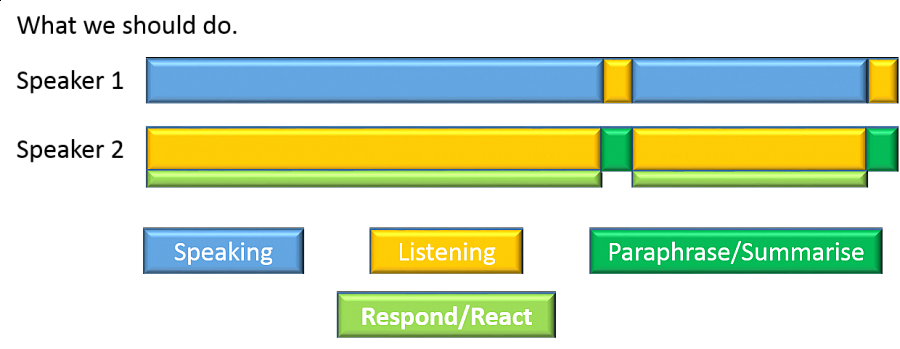In modern business this is almost a no brainer – of course we should talk to our customers. So it will probably come as a surprise when I say “no, we shouldn’t”.
To explain this, let’s think about what actually happens when we talk to someone.
Most people think that a conversation between two people is like Figure 1.

Speaker 1 speaks and Speaker 2 listens, then Speaker 2 speaks and Speaker 1 listens. It is then Speaker 1’s turn to speak again, and so on. However, this is rarely the case. Most of the time, the conversation goes like Figure 2.

Speaker 1 starts. Speaker 2 listens for a short period and then starts to think about what he is going to say. He then starts listening again, but only for a pause where he can break in. Speaker 1 then starts listening but quickly starts to think about his response and so on. Sometimes the “listener” will not wait for a gap and will just start speaking before the speaker is finished.
When you really want to know what someone is saying and what they mean you need to listen actively. Active Listening is not simply politely listening and waiting until the speaker finishes before talking yourself. It is much more than that. Active Listening means 100% focus on the person you are speaking with and what they are saying. This may sound easy but it is not. There can be many barriers such as:
In order to listen actively, we need to learn how to be aware of these barriers and how to deal with them and focus on the person we are speaking with. There are a series of techniques that can help us to do this.

Don’t forget about the power of silence. Often, when someone stops speaking, they still have more to say. If you immediately start talking, they may never say it, but if you hold back, even for jut ten seconds or so, they will probably start talking again. By this time, the obvious, surface issues will have been raised but silence can be a more effective tool for getting at the real issue than any amount of carefully worded questions.
By using these simple techniques you can come to a better understanding of the issues as seen by other people.
One final comment on Active Listening. Once you get used to it, it can be a relatively easy tool to apply but it can be tiring. As with any tool, you should pick it up and use it when it is the best tool for the job. Don’t try to use it every time you speak with someone.
So now we know how to listen, what should we listen for? Most people, even when they are actively listening, are looking for things that they agree with. Things that confirm their expectations. It may be a good ego boost to hear that you were right, but it is not particularly helpful in learning more about your customers’ needs. More useful are the things you don’t expect.
What don’t you agree with?
What has she said that you didn’t expect?
Where are you wrong?
This last question is possibly the most important – in 6 decades on this earth, I have never learned anything by being right. All my learning has come from being wrong and correcting that. Once you are able, and willing, to challenge what you “know” you will be open to learning new things about your customers and their needs.
So in summary, we should not talk to our customers – we should listen to them.
PMI Aberdeen EventBlinking Fast and Slow (The importance of cognitive ...
There are stories, going back to ancient Greece, of dolphins helping stranded ...
Her: So, what do you do?Me: I help companies to think out of the box and act in ...
In my work, I have frequent discussions with people about innovation. These ...